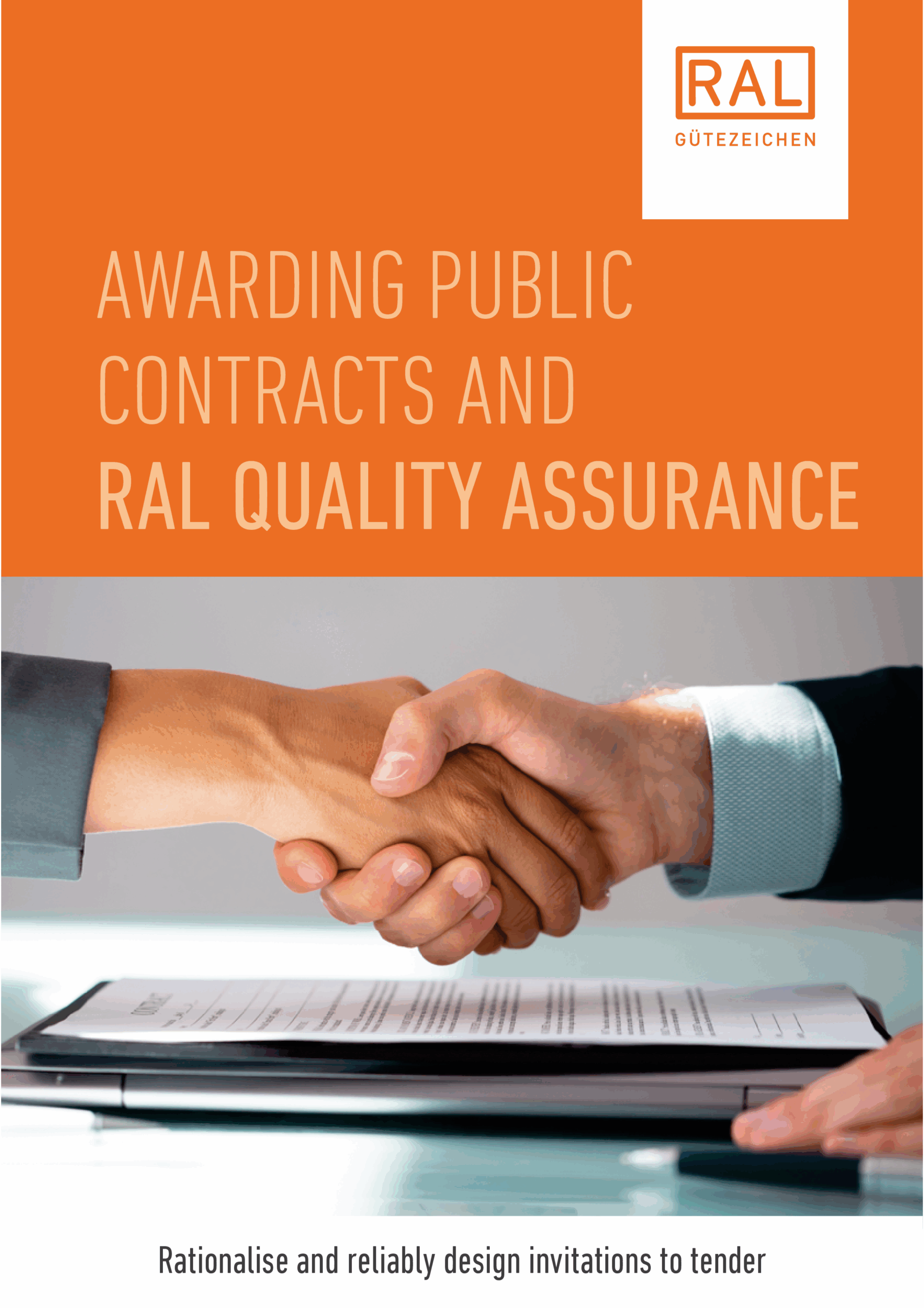Invitations to tender
RAL Quality Marks simplify public invitations to tender
RAL Quality Marks simplify public invitations to tender
Many RAL Quality Marks (RAL Gütezeichen) are accepted as proof of the bidder’s eligibility and their fulfilment of the delivery conditions in the invitation to tender. This is made possible by the strict Quality Assurance and Test Specifications that all products and services have to fulfil in order to be awarded with a RAL Quality Mark – and which cover all relevant characteristics. These specifications not only focus on a company’s reliability and performance capabilities but also on the relevant technical requirements placed on their products and services. A RAL Quality Mark verifies that these requirements are permanently fulfilled. If awarding authorities base their invitations to tender on these Quality Assurance and Test Specifications, they can easily accept RAL Quality Marks as proof of the bidder’s eligibility and their fulfilment of the delivery conditions. This process meets all of the legal requirements stipulated in public procurement law.
Explanatory video
Advantages for awarding authorities
The advantages for awarding authorities at a glance:
- Reliable criteria for bidder eligibility
- Performance requirements correspond to the very latest technological standards
- Requirements go above and beyond existing standards and legal requirements
- Shorter processes for invitations to tender
- No detailed checking of tender applications required
- Reliable contractual partners and clear delivery conditions

Law for the Modernisation of Public Procurement
The Ordinance on the Award of Public Contracts (Verordnung über die Vergabe öffentlicher Aufträge (VgV)) has been in force since 2016. Section 34, ‘Furnishing of Proof through Quality Labels’, clearly states that public contracting authorities may require Quality Marks in their tenders. The requirements listed therein are fully met by RAL Quality Marks.
Finding invitations to tender made easy
| WWW.EVERGABE-ONLINE.DE | Tender platform of the Federal Ministry of the Interior (Beschaffungsamt des Bundesministeriums des Inneren) |
| WWW.BUND.DE | Portal of the Federal Office of Administration (Bundesverwaltungsamt) with public invitations to tender of the last seven days |
| WWW.DTVP.DE | The German tender portal |
| WWW.EVERGABE.DE | 25 years of experience – Database for Invitations to tender and orders |
| WWW.BI-AUSSCHREIBUNGSDIENSTE.DE | The tender portal from bi medien GmbH publishes more than 550,000 invitations to tender annually |
| WWW.INFODIENST-AUSSCHREIBUNGEN.DE | This tender service publishes more than 1.5 million notifications per year |
| WWW.SUBMISSION.DE | A tender service for public and private invitations to tender, especially in the construction sector |
| WWW.SUBREPORT.DE | Information service for public invitations to tender |
| WWW.VERGABE24.DE | Joint platform representing the official gazettes and tender services of Bavaria, Baden-Württemberg, Hesse, Rheinland-Palatinate, Saarland, Saxony-Anhalt, Thuringia, the German Tender Journal (Deutschen Ausschreibungsblatt) and bi medien GmbH |
| WWW.DTAD.DE | DTAD (German Tender Service) publishes more than 200,000 invitations to tender annually |
| WWW.DEUTSCHES-WWW.AUSSCHREIBUNGSBLATT.DE | Portal for invitations to tender from public, commercial and private clients |
| WWW.AUSSCHREIBUNGEN.DGMARKET.COM | Information service about invitations to tender |
| WWW.EVERGABE.DE | 25 years of experience – Database for Invitations to tender and orders |
| WWW.TED.EUROPA.EU | TED (Tenders Electronic Daily) is a platform for European public procurement |
| WWW.TENDERS.EU | Portal for invitations to tender from the EU |
| WWW.GLOBALTENDERS.COM | Database with international and national invitations to tender |
| WWW.EUROTENDER.DE | Invitations to tender from the 27 EU member states, the GATT countries outside Europe and private companies |
RAL Quality Marks – in compliance with public procurement law
The German Regulation on the Award of Public Contracts (Vergabeverordnung) places three central requirements on public invitations to tender: They are not permitted to place any company at a disadvantage – meaning they must be non-discriminatory and treat all bidders equally. The tender specifications must be transparent and openly available to everyone. The invitation to tender must comply with the clauses governing the offer of products and services and cost efficiency, as well as taking special account of the interests of small and medium-sized companies.
These requirements are met by RAL Quality Marks:
- Transparency:
Products and services only receive a RAL Quality Mark when they fulfil the relevant Quality Assurance and Test Specifications. These Quality Assurance and Test Specifications are developed for each RAL Quality Mark in a broad-based public approval process. They are then subsequently published by RAL and accessible to anybody. - Non-discrimination and equal treatment:
RAL involves independent institutions such as the federal and state ministries, industry associations, consumer organisations and testing institutes in the development of the Quality Assurance and Test Specifications. This excludes the possibility of any preferential treatment of or discrimination against individual market participants. In addition, all German and foreign companies have the opportunity to apply for a RAL Quality Mark. - Clauses governing the offer of products and services and cost efficiency:
RAL Quality Marks embody characteristics such as durability, specialist personnel or reliable customer services – and thus fulfil the corresponding clauses in public procurement law. The interests of small and medium-sized companies are also taken into account because it is these companies in particular that often use RAL Quality Marks.

Glossary
The Quality Assurance and Test Specifications that are valid for issuing a RAL Quality Mark cover all relevant characteristics of a product or service. This also includes, for example, requirements for the reliability, performance capabilities and expertise of the suppliers. It is for this reason that awarding authorities can safely draw on the Quality Assurance and Test Specifications as criteria for ascertaining the bidder’s eligibility, as well as accepting the relevant RAL Quality Mark as proof that these standards have been met.
Foreign companies are free to acquire RAL Quality Marks. Just like for every other company, the prerequisite is the complete fulfilment of the Quality Assurance and Test Specifications. There are currently companies from around 30 countries across the world that offer their products or services with RAL Quality Marks. Clauses governing the offer of products and services and cost efficiency. RAL Quality Marks embody characteristics such as durability, specialist personnel or reliable customer services. This fulfils this clause for public invitations to tender.
Public invitations to tender based on the RAL Quality Assurance System are also open to bidders that do not hold any RAL Quality Marks. The prerequisite is that these companies fully comply with the specifications and verify their compliance through a test certificate. The difference is that RAL Quality Marks represent constant proof of this level of quality due to the continuous monitoring of the Quality Assurance and Test Specifications. In contrast, test certificates need to be newly completed for every invitation to tender.
An EU Directive (2014/24/EU) that came into force in 2014 confirmed that public authorities can utilise quality marks when they want to purchase construction services or other products and services.
Companies that hold a RAL Quality Mark constantly monitor their adherence with the Quality Assurance and Test Specifications. Furthermore, regular checks are also carried out by independent testing institutes. This ensures that the high quality standards associated with RAL Quality Marks are permanently maintained.
Public invitations to tender based on the RAL Quality Assurance system completely fulfil this requirement because the Quality Assurance and Test Specifications are defined by RAL in consensus with independent institutions such as the German Federal and State Ministries, industry associations, consumer organisations and testing institutes. This excludes the possibility of any preferential treatment of or discrimination against individual market participants.
RAL quality marks represent characteristics such as durability, expert staff and reliable customer service. These qualities meet the requirements of public invitations to tender.
RAL Quality Assurance Associations represent a group of companies that use the RAL Quality Mark for a specific type of product or service. Amongst other things, they award the RAL Quality Mark, monitor adherence with the Quality Assurance and Test Specifications and penalise any infringements.
The constant fulfilment of the Quality Assurance and Test Specifications is the prerequisite for issuing RAL Quality Marks to products and services. Adherence with these specifications is regularly monitored by those holding the RAL Quality Mark and also by independent institutions. The Quality Assurance and Test Specifications comply with the important clauses found in German public procurement law – such as the non-discrimination clause, the equal treatment clause and the transparency clause.
The RAL quality assurance system describes the entire process that is associated with the creation of a RAL Quality Mark: From the foundation of a RAL Quality Assurance Association, the development of the Quality Assurance and Test Specifications and their monitoring through to awarding the RAL Quality Mark.
The Quality Assurance and Test Specifications cover all relevant characteristics of a product or service. They do not only include e.g. the technical performance specifications but also requirements for the reliability, performance capabilities and expertise of the suppliers. It is for this reason that awarding authorities can safely draw on the Quality Assurance and Test Specifications as criteria for ascertaining a bidder’s eligibility and their fulfilment of the technical specifications, as well as accepting the relevant RAL Quality Mark as proof that these standards have been met.
RAL Quality Marks represent particularly reliable and trustworthy labels. The reason for this is the constant monitoring to which those companies holding the RAL Quality Mark submit themselves. The awarding authority can thus be certain that RAL Quality Marks stand for characteristics such as efficiency, environmental compatibility, safety, customer orientation and specialist personnel.
The German Regulation on the Award of Public Contracts sets strict limits on public invitations to tender. This is particularly true when it comes to the transparency of the invitations to tender, non-discrimination and equal treatment for bidders, clauses governing the offer of products and services and cost efficiency, as well as taking into account the interests of small and medium-sized companies.
Public invitations to tender based on the RAL Quality Assurance System protect the interests of small and medium-sized companies because it is these companies in particular that often use RAL Quality Marks.
As the Quality Assurance and Test Specifications cover all relevant characteristics of a product or service, this also naturally includes the technical specifications. It is for this reason that awarding authorities can safely draw on the Quality Assurance and Test Specifications as criteria for ascertaining the fulfilment of the technical specifications, as well as accepting the relevant RAL Quality Mark as proof that these standards have been met.
Quality Assurance Associations, whose RAL Quality Marks are particularly relevant to public authorities, provide these authorities with support, for example, in the form of suggestions for the formulation of the invitation to tender or with concrete performance specifications.
Public authorities can utilise the RAL Quality Assurance System both above and below the contractual threshold values set for the invitation to tender. The relative size of the contract is crucial in deciding whether the invitation to tender is subject to just national public procurement law or is also additionally subject to European procurement law. Foreign companies have exactly the same access to RAL Quality Marks as German companies.
RAL Quality Marks are only issued to products or services once they have fulfilled the relevant Quality Assurance and Test Specifications. These specifications are developed for each RAL Quality Mark in a broad-based public approval process. They are then subsequently published by RAL and accessible to anybody.
Reliable proof of a bidder's eligibility
In contrast to general standards, the Quality Assurance and Test Specifications cover all characteristics of a product or service that are important for their use. They not only include technical performance specifications but also requirements for the reliability, performance capabilities and expertise of the suppliers. It is for this reason that awarding authorities can safely draw on the Quality Assurance and Test Specifications as criteria for ascertaining a bidder’s eligibility and their fulfilment of the technical specifications, as well as accepting the relevant RAL Quality Mark as proof that these standards have been met. This significantly simplifies the tender process.
RAL Quality Marks as partners of public authorities
RAL Quality Marks support public authorities in the fulfilment of their public contracts:
- Economical use of tax revenues: Energy efficiency and clearly defined costs play a central role in the awarding of construction contracts. In the construction sector, awarding authorities can make use of a wide range of products and services with RAL Quality Marks that fulfil these requirements. Products and services with RAL Quality Marks also protect against shoddy workmanship at the construction site and thus prevent any unanticipated follow-up costs. This is due, amongst other things, to the use of high-quality materials, qualified and regularly trained employees and long guarantee periods.
- Citizens rely on a functioning infrastructure: The municipal infrastructure is judged on whether it is safe and functions correctly. In this area and also for other infrastructure measures, RAL Quality Marks stand for high-quality, environmentally-friendly and sustainable solutions, as well as for trained specialist personnel, modern technology and high-quality materials. This protects against defects, repairs and disgruntled citizens.
- Responsibility for cleanliness and health protection: Cleanliness and hygiene play an important role in public facilities. This is particularly true when it comes to kindergartens, schools, hospitals or care facilities. The reliability and trustworthiness of service providers is decisive in this area. RAL Quality Marks also make all the difference in these sectors.
- Green spaces increase the quality of life: Citizens love their green spaces and they thus need to be maintained. Those businesses who deliver services awarded with a RAL Quality Mark offer much more than just gardening expertise. They also handle, for example, the cultivation of indigenous trees, create habitats for fauna and flora and maintain recreational facilities. In the case of dangerous work such as tree husbandry, these companies make safety their primary objective.
- Expertise for the awarding authority: Some Quality Assurance Associations, whose quality marks are particularly relevant to public authorities, provide these authorities with support, for example, in the form of suggestions for the formulation of the invitation to tender or with concrete performance specifications. If public authorities make use of these suggestions, they are provided with tender specifications that go above and beyond the relevant standards and legal regulations.

